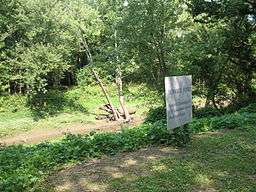Blue River (Missouri River)
| Blue River | |
| Big Blue River | |
| River | |
 Blue River at Byram's Ford where the Battle of Byram's Ford (a skirmish of the Battle of Westport) was fought by Swope Park | |
| Country | United States |
|---|---|
| States | Kansas, Missouri |
| Part of | Missouri River |
| Tributaries | |
| - left | Brush Creek (Blue River) |
| City | Kansas City |
| Source | |
| - location | East Johnson County, Kansas, United States |
| - elevation | 725 ft (221 m) |
| - coordinates | 38°48′31″N 094°40′50″W / 38.80861°N 94.68056°W [1] |
| Mouth | Missouri River |
| - location | Kansas City, Missouri, United States |
| - elevation | 221 ft (67 m) [1] |
| - coordinates | 39°07′48″N 094°28′15″W / 39.13000°N 94.47083°WCoordinates: 39°07′48″N 094°28′15″W / 39.13000°N 94.47083°W [1] |
| Length | 39 mi (63 km), Northeast [2] |
 Blue River in the Kansas City metropolitan area
| |
The Blue River (also known as the Big Blue River) is a 39.8-mile-long (64.1 km)[2] stream that flows through Johnson County, Kansas and Jackson County, Missouri in the Kansas City Metropolitan Area. The river rises in Johnson County near the border of the states of Kansas and Missouri. Crossing the city of Kansas City, Missouri, it empties into the Missouri River near the border between Kansas City and Independence, Missouri.
Its major tributaries are Brush Creek, Tomahawk Creek, and Indian Creek.
Recreational Activities
Along the Blue River can be found many miles of hiking, biking, and walking trails. Portions of these trails can be found along the flat, engineered areas of a former steam railroad bed, the former location of the Missouri Pacific Railroad line that ran from Dodson, Missouri south to Martin City, Missouri. This railbed followed the Blue River and had many curves. The route was straightened in 1954 with the use of three high trestle bridges over the Blue River and one substantial cut. This improved line is now the Union Pacific / KC Southern Mainline and generally parallels the Blue river into the bottoms railyard near Front Street in Kansas City.
History
On the high bluffs overlooking the confluence of the Blue River and the Missouri River can be found a large Native American mound structure, designated as Indian Mound Park in the Indian Mound neighborhood of Kansas City, Missouri.
The three western trails, the Santa Fe, Oregon, and California trails crossed the river just north of Red Bridge Road and Minor Park. Mountain man/ fur trapper Jim Bridger had a trading post at this location.
During the Civil War, the Blue River was the site of the Battle of Byram's Ford.
See also
References
- 1 2 3 "Blue River". Geographic Names Information System. United States Geological Survey. 1978-10-13. Retrieved 2013-08-17.
- 1 2 U.S. Geological Survey. National Hydrography Dataset high-resolution flowline data. The National Map Archived 2012-04-05 at WebCite, accessed May 31, 2011